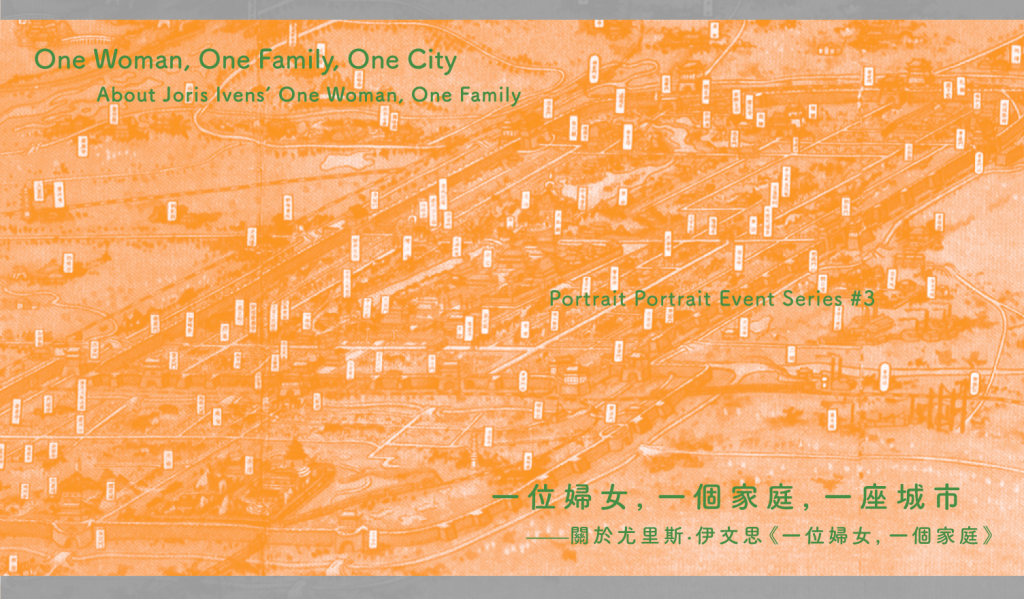For English, please scroll down.
肖像擺 系列活動 #3:一位婦女,一個家庭,一座城市——關於 尤里斯·伊文思《一位婦女,一個家庭》
時間:2016年10月26日(三),晚上7-9點
地點:台北當代藝術中心,台北市保安街49巷11號(捷運大橋頭站)
主講人:小孔(書寫建築工作室)
在中國,使我感動的是真實而具體的工作。中國人不僅僅是在社會主義制度下發展工農業和科學,而且是在造就新型的人。這種人在他的工作、生活以及他與別人的關係中,都具有真正的社會主義覺悟。——伊文思《攝影機和我》,北京,297頁。
安東尼奧尼《中國》和伊文思《愚公移山》,作為西方關於1970年代中國的唯一影像紀錄,本身具有特殊的政治含義,更有著全然不同的命運。其中,《愚公移山》拍攝歷時五年,包括12部系列影片,總片長12小時,其中的兩部影片是在長辛店拍攝的,而《一位婦女,一個家庭》片長110分鐘,從一個女性主義的視角完整記錄了當時的生產生活。本次座談希望結合歷史文獻和拍攝親歷者的回憶,闡釋這部影片中的各種細節,以及與今天小孔、李墨《長辛店記》藝術計劃的關聯。
本次座談將圍繞著這部影片中的三代女性,包括主人公高淑蘭(時任二七機車工廠工會副主任),她的母親和她的女兒,以及她們身邊的其他女性,如高淑蘭在二七廠的工友們,在仁壽域的鄰居們,她的婆婆和侄女,西瓜攤位的女店員,以及在陶然亭公園玩耍的女孩子等。三代女性在身體和認同上的差異,勾勒出1970年代中國典型的新女性形像,即某種新型的人,進而,組織成為某種新型的家庭,以及在家庭隱喻意義上某種新型的工廠,作為當時的新生事物,所有這些,尚有待於大歷史視野的回顧。
《長辛店記》始於2015年初,至今已完成三個階段,旨在面對工作方法的邊緣性,以及作品投放的在地性。所謂的邊緣方法,並不意味著某種中心實踐的低配版,或者對中心實踐的簡單對抗,而是從邊緣樹立新的價值導向。所謂的在地投放,並不意味著某種特定地點的介入版,或者對特定地點的簡單調查,而是從在地建構新的生產模式。在此意義上,《一位婦女,一個家庭》給予的啟示,是如何從某種新型的家庭,再次上升為某種新型的城市,即一種無法預先看見的,也無法預先構想的共同體場域,這是我們要去思考與行動的。
關於主講人:
行動作為生產模式,是為書寫建築工作室的建築師李墨和小孔所致力在思考與探索介於理論思辨與建造技藝之間的可能。透過公共性計劃促進社群對於居所空間進行關注、思考、對話與實驗,以樹立新價值導向的邊緣方法以及建構新生產模式的在地投放,輸出具書寫意涵的當代城市設計。目前工作與生活於北京。
Portrait Portrait Event Series #3: One Woman, One Family, One City——About Joris Ivens’ One Woman, One Family
Time: 2016.10.26 (Wed.) 7-9pm
Venue: Taipei Contemporary Art Center, No. 11, Lane 49, Baoan Street, Taipei (MRT: Daqiaotou Station)
Speaker: Kong (Calligraphy Architecture Studio)
In China, what touched me was the real deal in their work. Chinese people do not just develop industry, agriculture and science under the name of socialism, but also create a new type of people who are fully aware of socialism ideas in their work, life and relations with other people.
Joris Ivens, The Camera and I, Beijing, p. 297.
Michelangelo Antonioni’s Chung Kuo and Joris Ivens’ How Yukong Moved the Mountains are the only documentary films about China from the Western perspective in the 1970s, conveying specific political implications and heading to different destinies. It took five years for Ivens to produce How Yukong Moved the Mountains, which includes twelve episodes in the total length more than twelve hours. Two of them were filmed in Chang Xin Dian. The 110 minutes episode One Woman, One Family completely captured the production life from a woman’s viewpoint. This artist talk will address to the archival materials and the original casts’ memories in a close reading, and discuss how these are related to Li Mo & Kong’s ongoing Chang Xin Dian Project.
The talk will focus on three generations of women in this film, including the protagonist Kao Shulan (the formal vice manager of 27 motorcycle factory union), her mother, daughter and other women around them, like other colleagues in 27 motorcycle factory, neighbors in Ren Shou Yu, her mother-in-law and niece, the female sale in the watermelon vendor and girls in Tao Ran Ting Park, etc. The variations of three generations’ women’s concepts for body and the sense of belongingness capture the classical new woman’s image in the 70s China, the new type of people in return. These women organized a new kind of family, which metaphorically could be seen as a new type of factory, a product of that specific era. All these await new reviews in a larger historical framework.
Since 2015, Chang Xin Dian Project has completed three phases to deal with the marginal work method and the local practice through various art projects. The so-called marginal method is not a lower version of central practice or its opposition. It concerns how we can establish new values from marginal places. The local practice does not suggest any intervention to a specific site, or a simple research on a specific site, but intents to construct new production models from the local. So to speak, One Woman, One Family inspires us how we can create a new type of city based on formulating a new type of family, which resembles the coming community neither foreseen nor preconceived. This is perhaps what we should consider and put into action.
About Speaker:
LI Mo & KONG studies the connection between theoretical speculation and architectural techniques. The studio explores new horizons for urban design and its related art through “Calligraphic” interpretations. Their public projects, brings the community attention, thinking, conversations and experiments to build up the margin method which leads a new set of values formed within and the local launch of a new production pattern constructed at a locale. Calligraphy Architecture Studio is based in Beijing.

